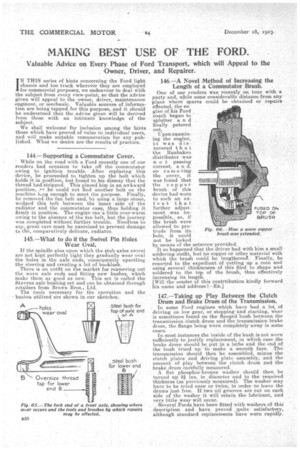MAKING BEST USE OF THE FORD.
Page 12

If you've noticed an error in this article please click here to report it so we can fix it.
Valuable Advice on Every Phase of Ford Transport, which will Appeal to the 'Owner, Driver, and Repairer.
IN THIS series of hints concerning the Ford light chassis and ton truck wherever they are employed for commercial purposes, we endeavour to deal with the subject from every view-point, so that the advice given will appeal to the owner, driver, maintenance engineer' or mechanic. Valuable sources of information are being tapped for this purpose, and it should be understood that the advice given will be derived from those with an intimate knowledge of the subject.
We shall welcome fbr inclusion among the hints those which have proved of value to individual users, and will make suitable remuneration for any published. What we desire are the results of practice.
144.—Supporting a Commutator Cover.
While on the road with a Ford recently one of our readers had occasion to take off the commutator owing to ignition trouble. After replacing this device, he proceeded to tighten up the bolt which holds it in position, but found to his dismay that the thread had stripped. This placed him in an awkward position, P. he could not find another bolt on the machine king enough to meet the purpose. Finally, he removed the fan belt and, -by using a large stone, wedged this belt between the inner side of the radiator and the commutator casq, thus holding it firmly in position. The engine ran a little over-warm owing to the absence of the fan belt, but the journey was completed without further trouble. Needless to say, great care must be exercised to prevent damage to the, comparatively delicate, radiator.
145.—What to do if the Swivel Pin Holes Wear Oval.
If the spindle pins upon which the stub axles swivel are not kept perfectly tight they gradually wear oval the holes in the axle ends, consequently upsetting the steering and creating a lot of backlash. There is an outfit on the market for reamering out the worn axle ends and fitting new bushes, which make them as good as new. This set is called the Stevens axle bushing set and can be obtained through retailers from Brown Bros., Ltd.
The tools necessary for the operation and the bushes utilized are shown in our sketches.
146.—A Novel Method of Increasing the Length of a Commutator Brush.
One of our readers was recently on tour with a party and, while some considerable distance from any place where spares could be obtained or repairs effected, the engine of his Ford coach began to splutter a n d finally petered out.
Upon examining the engine, it was discovered that the Runbaken distributor was, n o t passing current, a n d, on rem oving the cover, it was found that tielne the copper brush • of this device had worn to such an extent that further adjust FUSED ON rnent was imOA-A, TOP OF possible as, if BRUSH the brush were allowed to protrude from its hole, it could not be locked by means of the setscrew provided.
It so happened that the driver had with him a small soldering outfit, but no copper or other material with which the brush could be lengthened. Finally, he resorted to the expedient of cutting up a coin and using several thicknesses of this filed to shape and soldered to the top of the brush, thus effectively increasing its length. [Will the sender of this contrtibution kindly forward his name and address l--ED.] Fig. 66. How a worn copper brush was extended.
• 147.—Taking up Play Between the Clutch Drum and Brake Drum of the Transmission.
. In some Ford engines which have had a lot of driving on low gear, or stopping and starting, Wear is sometimes found on the flanged bush between the transmission 'clutch drum and the transmission brake drum, the flange being worn completely away in some cases.
In most instances the inside of the bush is not worn. sufficiently to justify replacement, in which case the brake drum should be put in a lathe and the end of the bush trued up to make a smooth face. The transmission should then be assembled, minus the clutch plates and driving plate assembly, and the amount of play between the clutch drum and the brake drum carefully measured.
A flat phosphor-bronze washer should then be turned up 21 ins, in diameter and to the required thickness (as previously measured). The washer may have to be tried once or twice, in order to leave the drums just free. If two oil grooves are cut on each side of the washer it will retain the lubricant, and very little wear will occur. Several Fords have been fitted with washers of this description and have proved quite satisfactory, although standard replacements have worn rapidly.






























